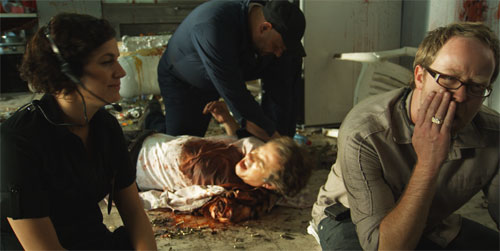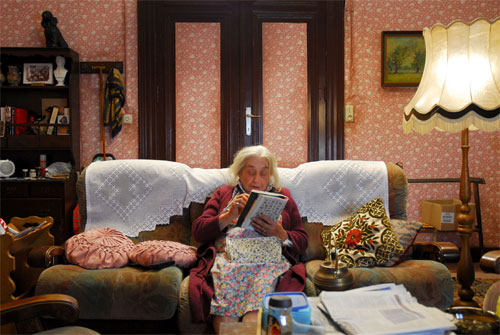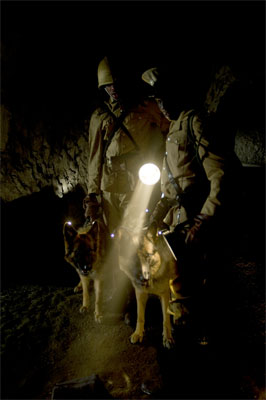
(Image courtesy of Postmasters gallery)
Between two recent solo exhibitions in New York, at The Whitney Museum of American Art and Postmasters gallery, the popular Jerusalem-born, Berlin-based artist Omer Fast presented three film installations in continued pursuit of his driving preoccupations: the fact/fiction dialectic that underlies film, and the resulting description of any tangible identification of “truth” as abstract.
Fast is known for a practice of importing subjects into culturally fraught scenarios appropriated from the past (Nazi-occupied Poland, colonial America), the present (Iraq) and, perhaps (in the case of the vaguely post-apocalyptic Whitney project), the future. It may seem contradictory to regard setting a film in the present a form of historical borrowing—whose time is this time but ours?—however, if anything is certain about Fast’s otherwise deliberately ambiguous system of filmmaking, it is that casting the setting is always a performative gesture; setting is setting into place and into time. Fast sets human elements into artificial contexts, and any temporal dissonance lacking between where his subjects come from and where they are put is made up for in the unbreachable gap that exists between the experience of being and of being recorded.
Fast’s show at Postmasters, his third since 2002, includes two videos, De Grote Boodschap (2007, 27 min.)—translated literally from the Flemish as “the great message”—and Take a Deep Breath (2008, 27 min.). Neither employs ostensible documentary techniques, in fact their scripts are weighted by a density of plotty clues and keys smuggled in prosaic lines; lines nested in average characters; characters staged in ordinary scenes; scenes camouflaged in a purposefully nondescript aesthetic. The gestalt is a conspicuous banality. To capitalize on this configuration, Fast crafts a suspense that never sags nor hurries, and in doing so, he instills the disquieting feeling that beneath the surface, an epic profundity demands attention. What might be “the great message” of De Grote Boodschap? Probably to recognize that such a title is more nebulous than it purports to be, and though such a title may negate itself, the message does not, or is it the other way around?

(Image courtesy of Postmasters gallery)
While both films are undeniably written and stylized as narratives, both are guided by the documentary staple of testimony. In De Grote Boodschap, the camera passes horizontally through the walls of seemingly adjacent rooms in an apartment building, pausing on each to overhear a two-person conversation. As viewers, we begin to piece together an impression of what’s going on, taking, with an abundant side of suspicion, what is presented to us as fact.
One inhabitant, an old woman, escalates into monologue as she recounts the eerie childhood memory of her father swallowing diamonds. In the next room, a shirtless fellow sits across from his girlfriend’s bed and beatboxes. The sounds he makes belie their source (his mouth). When he stops, something curious occurs; another actor has taken his place and the scene continues. Is this moment the subtle ridge between beginning and end, like the end of a roll of tape that can be so frustrating to catch? It is neatly revealed that the girlfriend and the new boyfriend both work in the old woman’s apartment (which indeed must not be next door): she as her nurse, and he as the real estate agent renting the place after her death. Or, it is revealed that the nurse and the agent are dating—depending on where and when you enter the narrative.
In one sense, perspective formed by the point of entry is arbitrary. Upon multiple viewings, subjective beginnings and ends wash away. Disparate points of entry belie a common orientation. It is the relationship between the viewer and the characters that truly orients the film experience, and the viewer and characters always begin and end the film together, in medias res. All are set into place and time by the director.
The role of the director is rendered explicitly in Take a Deep Breath, a dual screen projection to which Fast’s aforementioned palpable banality does apply, however not by all appearances. The work is set in a Los Angeles film set dressed as a Jerusalem falafel shop where a suicide bomber has detonated himself. Perceiving this otherwise grisly scene as a film within a film inserts some distance from the gore. In fact the bomber/actor is subject to jokes and ridicule from the protuberance feigned by a crease in his pants, to criticism of his ability to properly appear dead, which leads to his dismissal from the production. Variously disgruntled and indifferent crew members go about their on-set routines, making contact with subjectively versioned, circularly linked events that, like being on a film set, sound more exciting than they actually are: an explosion, a 911 call, disruptive cops, and doubts as to the true identity (and mortality) of the phantom-like suicide bomber.

(Image courtesy of Postmasters gallery)
Take a Deep Breath’s two channels (in the gallery installation the screens are suspended in a black room, side by side, one set back a couple inches from the other) appear to be synced in time, differing only by the positions of the cameras during each take. However in a story whose express purpose is to offer multiple, rationally competing iterations of itself, one is left to wonder if the two projections were shot simultaneously, or if there is a break between them that has been reduced to subliminal hypothesis by the filmmaking process.
The most recent of Fast’s three projects is the three-part film installation Nostalgia (2009) at the Whitney. The viewer retreats into three screening spaces that increase in size and privacy, and whose films increase in duration and complexity. Nostalgia I (4 min.) presents the central trope of the series: a Nigerian man’s reminiscent instructions for how to build a primitive hunting trap from material found in nature, which he voices over a video demonstration of how to build it. In Nostalgia II (9 min.), the Nigerian man, now a refugee, appears onscreen for the first time. A white filmmaker in London interviews him about his childhood in Africa, and in the process he has occasion to summon the trap building story. With a deceptively modest foundation laid by the first two films, Nostalgia III (32 min.) embarks on a grand, Möbius strip-like tour of concatenated incidents in which European refugees are grilled by humanitarian administrators and hunted in underground tunnels as they attempt to enter an unnamed African state. Along the way, the trap story is repeated four times, each by a character that passes it on as their own, after hearing it from another.

(Image courtesy of Postmasters gallery)
This paradoxical provenance of the trap story is a powerful exemplum of the mysteries and falsehoods that originate from any story. As oral transferences of private experience to public account, stories take form through the ossification of subjective approximations as facts. This conundrum is a base material of all Fast’s films, whose complexity is compounded by the fact that the director dares to approach fiction at all. Nevertheless he does, and in an exceptional way that does not lean too much on the tempting gestural power of historical appropriation, but harnesses enough of it to imbue independent narratives with a memorable and irreparable sense of displacement.
Kevin McGarry is a writer and curator based in Brooklyn, New York. He is a co-director of Migrating Forms, an annual festival of new experimental film and video, whose 2010 edition will run May 14-23 at Anthology Film Archives.

